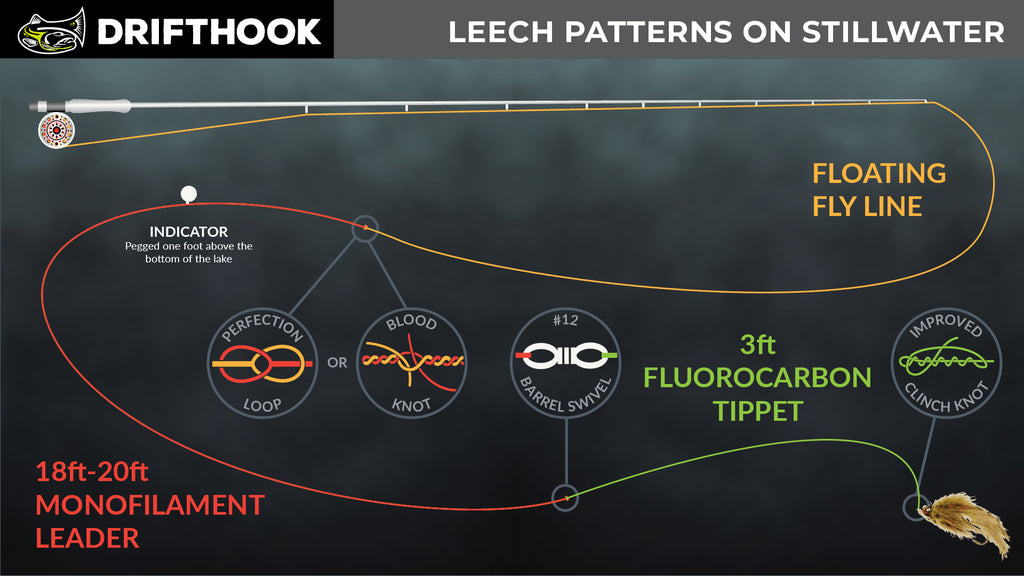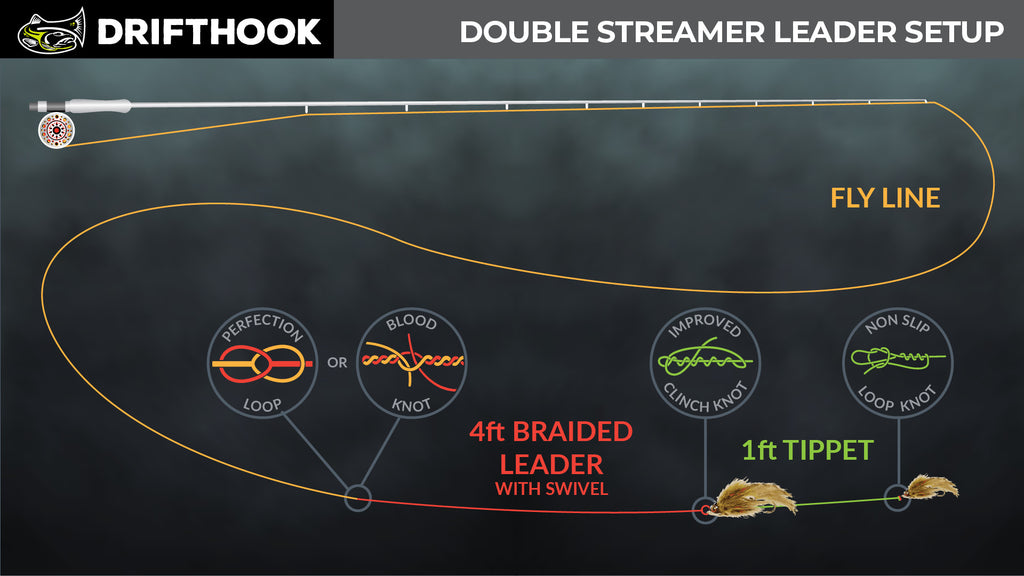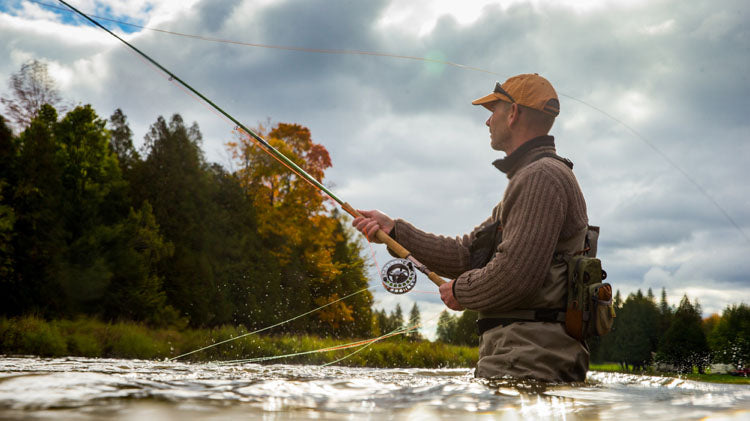
A frequently asked question here at Drifthook Fly Fishing is, “How long should my leader be?” And the simple answer is… it depends. Well, it depends on a few different factors:
- What size of fish you’re going after
- What style of fly fishing you’re doing
- How pressured the fish is that you’re going after
In this article, we’re going to discuss a handful of different leader lengths and rig setups that you can use when you’re out on the water. Combined with the fly selections from Drifthook in our Fly Fishing Kits these combinations will have you landing more trout than ever before.
Before we dive into the actual length that’s needed, let’s discuss the proper poundage (or “X” size) that is needed for the fish you're hunting. As shown in the diagram below, X size depends on what type of fish you’re going after. For the purposes of this article, we’ll discuss trout leader setups, since that’s what we specialize in here at Drifthook Fly Fishing.
Now that you have a good idea of what poundage (or “X” size) you should be using we can dive into specific leader setups depending on what type of fly fishing you are doing. At Drifthook we focus on catching MONSTER Trout so we will discuss different leader setups to help you do just that. Remember each setup is used in different scenarios depending on how you like to fish and what type of water you are fishing in.

NYMPH FLY FISHING LEADER SETUPS FOR MOVING WATER
The one that I like to fish when I’m out on the water is a simple 2-fly setup with a 9-foot leader.

Nymph Leader – 2-Fly Setup - General Fly Fishing Adventure
- 9ft 4x leader
- Clear bobber indicator
- Splitshot – 2 to 3 size 4
- Fly #1
- 12” to 14” 5x or 6x Tippet
- Fly #2
This fly fishing rig setup is used when nymphing moving water, such as a river or a stream. Weight can be added or removed depending on the depth of the feeding lane that you are fishing. To learn more about the feeding lane and reading water, watch our video in the free beginner series of our Members Portal.

Nymph Fly Fishing Leader – 90-degree Rig - 2-Fly Setup for Heavily Pressured Trout
- 2ft to 15ft 0X or 1X leader or 40lb Mono if you’re building your own leader
- Clear bobber indicator with a perfection loop
- #14 Swivel
- 6ft to 7ft of 6x or 5x tippet to the first fly. Tie fly on with the Improved Clinch Knot
- Split shot 12” to 16” above the first fly (add as needed depending on depth)
- 12” to 14” of 5x or 6x tippet to next fly
- The second fly tied with Non-Slip Loop Knot
This rig was brought to my attention this year at the Fly Fishing Expo in Denver by Matt McCannel, an amazing fly fishing guide, and fly designer from Ridgeway, Colorado. I have started using this setup exclusively when sight hunting MONSTER Trout and find it to be extremely successful. The key to this setup is that the line at the bobber makes a 90-degree turn. When the flies hit the water they swing down like a hinge at 90 degrees dropping the fly in front of the trout. The placement of the fly is important to give it time to swing down in front of that Monster for the take.

Nymph Fly Fishing – Drop-Shot Rig Setup
This is a great setup if you’re fishing deep pools or runs where you want to have multiple flies in different levels of the water column. This is also great for fishing dirty water because this setup and technique is deadly. You can fish as many flies as your heart desires, but check your local fishing laws to make sure you’re not breaking any rules. This can be fished with an indicator or tight lined.
- 8ft Leader 4x or 5x
- Clear indicator
- Weight on the bottom
- Overhand Knot, connect fly with a dropper loop
- Overhand Knot, connect fly with a dropper loop
- Continue as needed. Keep Flies 8" to 12" apart.
When fishing this setup, it’s best to keep as much line out of the water as possible. The idea is to have a tight connection from your rod tip to the weight that is bouncing along the bottom. This way, when you do have a take from a fish, you can quickly set the hook and bring that bad boy home. Also remember to use darker or dull-colored flies on the bottom and make your top flies lighter and shinier, as that is the natural color forms of flies as they move up the water column.

NYMPHING LEADER SETUPS FOR STILL WATERS
Still water fishes completely different than moving water such as rivers or streams. In rivers and streams, the water movement makes the fly move around naturally. On still water (lakes, ponds, etc.), you have to create the natural movement of the fly to attract a take. The best way to fly fishing in this scenario is knowing the movement of the particular fly that you are using. You will want to be fishing a leader up to 20% longer than the depth you are fishing.
Most fish are going to be feeding in the shoals, shallows, and dropoffs. So you will be fishing with leaders as short as 4ft or as long as 25ft, depending on your water depth and fly presentation. Below are the most common Stillwater setups and how to retrieve them to get the optimal results. If you need to find the exact depth, check out this article on the best depth finders.
Based on a 15ft feeding depth, below are the optimal lengths based on the fly that you are using. Some lengths are different because the retrieve of each fly is different and the lengths very to help with that retrieve.

Mayfly Nymphing on Still Water – 18ft Leader Length
- 13ft monofilament
- #12 barrel swivel (to add more weight)
- 5ft fluorocarbon tippet
- Weighted Mayfly Nymph such as Copper John or Flashback Hare’s Ear
- Slow hand roll retrieve

Caddis Nymphing on Still Water – 16ft Leader Length
- 11ft monofilament
- 5ft fluorocarbon tippet tied together using the Double Surgeon’s Knot
- Weighted Caddis Nymph such as a Holy Grail-Tungsten or a Hot Wire Caddis Bead-Head
- Slow 12-inch retrieve, pause, 12-inch retrieve, pause, continue

Midge Chironomid Pupa
- 18ft to a 20ft leader
- Bobber pegged at one foot above the bottom of the lake
- #12 barrel swivel (to add more weight)
- 3ft fluorocarbon tippet
- Tie on a Midge Chironomid flies, such as a Pure Midge Larva or a Zebra Midge
- Retrieve – slow hand twist

Midge Chironomid Pupa – Deeper than 20ft
- Use full sinking line
- 4ft leader monofilament or fluorocarbon tippet
- Tie on a Midge Chironomid flies, such as a Pure Midge Larva or a Zebra Midge
Find the depth of the water with a depth finder or by clipping your hemostats to the end of your line and slowly dropping it into the water. When your hemostats hit the bottom of the lake, mark your line and then pull it up to calculate your depth. After you have your depth, let the line sink sit straight up and down. Then do slow hand twist retrieves straight up to your boat.

Leech Patterns
- 18ft to a 20ft leader
- Bobber pegged at one foot above the bottom of the lake (So, for the 15ft depth, peg the bobber at 5’ from the fly line)
- #12 barrel swivel (to add more weight)
- 3ft of fluorocarbon tippet
- Leech Pattern fly
- Slow retrieve. Every 4 or 5 pulls, do a couple of quick short retrieves

Scuds Pattern
Scuds typically live in 20ft of water or less and live deep in the undergrowth. For this, we are going to use a full sinking line.
- Full sinking line
- 9ft leader
- Scud pattern flies, such as a Scud or Sowbug
Cast out and let your line sink to the bottom. Give at least a 20 count in your head before starting to retrieve. Start with a strip retrieve of 4-6 inch intervals or hand twist retrieve. Keep a steady retrieve with your rod tip in the water for a straight connection from the tip to the line to the fly.

Dragonflies – Nymph
- Full sinking line
- 7ft leader
- Slow strip retrieve 8-12 inches

Damselflies – Nymph
- Floating line
- 12ft leader
- Damsel Flies Nymph with a Non-Slip Loop Knot
Cast your Damselfly pattern out as far as you can and let it sink about 3ft before starting your retrieve. Then do a slow hand twist retrieve and pause every 3ft to let it sink a little more.

DRY FLY LEADER SETUPS – RIVERS AND STILL WATER
When the trout are rising or sipping on those emergers it is time to switch over to your dry fly presentations. Dry fly fishing is one of the most exciting fly fishing because you see your target taking the fly. The next few leader set-ups will explain the proper length for any given scenario.

SINGLE DRY FLY
This is a great setup if you’re just getting started and learning how to cast. It is the easiest to master and does not take a lot of explanation. If you find your line spooking the fish, add an additional 2 to 3 feet of tippet to the end using the Double Surgeon’s Knot to give you a little more room.
- Have the leader the same size as your rod
- Yes, if you have a 10ft rod, get a 10ft leader; 9ft rod, 9ft leader
- Single dry fly connected with the Improved Clinch Knot

DOUBLE DRY FLY – DRY DROPPER
If you find that the trout are taking smaller flies and you are having trouble seeing those flies, you’ll want to set your rod up with a two-fly setup and use the first fly as a visual indicator. If you see any movement around the first fly, then set the hook.
- Have the leader the same size as your rod
- Yes, if you have a 10ft rod, get a 10ft leader; 9ft rod, 9ft leader
- Attach the first fly to the end of the leader using the Improved Clinch Knot
- Add 12” to 14” of 5x or 6x tippet with the Improved Clinch Knot
- Add the second smaller fly with another Improved Clinch Knot

HOPPER DROPPER
In the summer months chucking large Hoppers near the banks can be a blast. I like to use a Hopper Dropper combo with a Hopper as the lead and a Nymph or Dry on as the second fly. Use your Hopper as an indicator. If it unnaturally moves then set the hook.
- Have the leader the same size as your rod
- Yes, if you have a 10ft rod, get a 10ft leader; 9ft rod, 9ft leader
- Attach the first fly to the end of the leader using the Improved Clinch Knot
- Add 12 to 14” of 5x or 6x tippet with the Improved Clinch Knot
- Add the second smaller fly with another Improved Clinch Knot
STREAMER FLY FISHING LEADER SETUPS
When streamer fishing for trout, you don’t need a long leader. The reason for this is because you are typically stripping in the line fast enough that the trout does not have enough time to be spooked by it. They are more aggressive to the imitation that you are sending by it. It is a predatory reaction and that is why streamer fishing can land you the largest trout and be the most exciting: big fish eat big meals. The leader setup is below.

SINGLE STREAMER FLY FISHING LEADER SETUPS
- 4 to 5ft of heavier monofilament. 3X weight or stronger
- Streamer pattern tied on with a Non-Slip Loop Knot

DOUBLE STREAMER FLY FISHING LEADER SETUPS
- 4 to 5ft of heavier monofilament. 3X weight or stronger
- Larger Streamer pattern tied on with a Non-Slip Loop Knot
- 12” to 16” monofilament or fluorocarbon tippet
- Smaller Streamer pattern
In future articles, we will discuss what type of retrieve is needed for streamer fishing. If you are interested in these leader setups or what flies to use for them, check out Drifthook’s fly fishing kits to get you catching more trout the next time you hit the water.
About the Author
Matthew Bernhardt, a third-generation Coloradan, grew up at the forefront of the state’s fly-fishing revolution, enjoying time on the water side by side with experienced guides and lifelong anglers.
By combining his passion for fly-fishing with input from other experienced fly-fishers and guides and his fine arts degree from Colorado State University, Matthew spent five years carefully developing the Drifthook Fly Fishing System, built to help every angler catch more trout.
When he’s not spending time with his wonderful family, you’ll find him out on the water catching MONSTER trout, and he anxiously looks forward to the day when his kids are old enough to join him there






7 comments
Paul
Thank you Matthew for your hard work in presenting all of this excellent information. I think I speak for others when I say that I would happily pay for these diagrams to be put together in a pocket-sized aide-memoire!
Best regards, Paul
Hereford, UK
Thank you Matthew for your hard work in presenting all of this excellent information. I think I speak for others when I say that I would happily pay for these diagrams to be put together in a pocket-sized aide-memoire!
Best regards, Paul
Hereford, UK
Joe Kissane
Wondering if you’ve read my book – I think it’s still available digitally – Drag-Dree Drift Leader Design and Presentation Techniques for Fly Fishing. I’ll read your piece again but it seems to follow the general ideas for various aspects of leader design. Since I did the work on my book, so many advances have occurred in manufacturing and materials that it probably needs an update, but I don’t know if a publisher would go for that.
Joe Kissane
Wondering if you’ve read my book – I think it’s still available digitally – Drag-Dree Drift Leader Design and Presentation Techniques for Fly Fishing. I’ll read your piece again but it seems to follow the general ideas for various aspects of leader design. Since I did the work on my book, so many advances have occurred in manufacturing and materials that it probably needs an update, but I don’t know if a publisher would go for that.
Joe Kissane
mike
You answered so many questions. I wish I found this early THX!!!!
You answered so many questions. I wish I found this early THX!!!!
Anthony Uzzo
Great information for a novice fly fisherman this is incredibly helpful.
Great information for a novice fly fisherman this is incredibly helpful.
Ryan
Is there a preferred setup for Trout in still water?
Is there a preferred setup for Trout in still water?
Paul kenyon
Very easy article to understand, thankyou
Very easy article to understand, thankyou
Ken
Great information in a very nice format! Well done! Sending to both of my Son in Laws ( they need the help :-)
Great information in a very nice format! Well done! Sending to both of my Son in Laws ( they need the help :-)